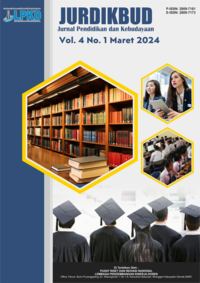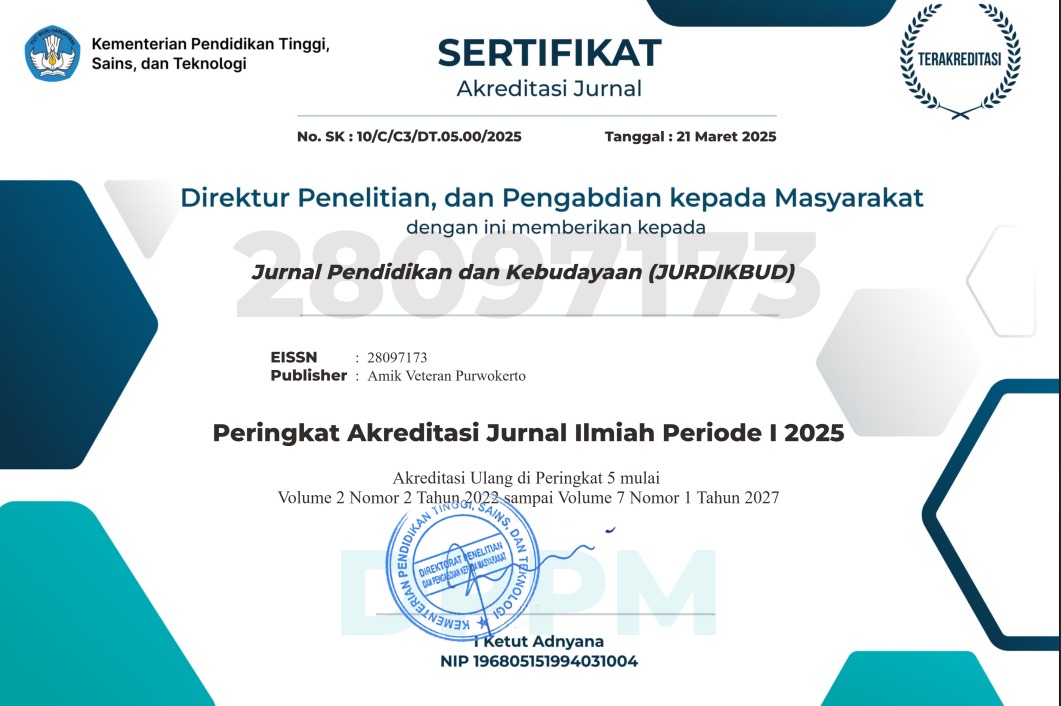Bentuk Aktualisasi Diri dalam Novel Luka Cita Karya Valerie Patkar Berdasarkan Kajian Psikologi Carl Rogers
DOI:
https://doi.org/10.55606/jurdikbud.v5i2.6457Keywords:
Carl Rogers' humanistic psychology, self-actualization, implications, Luka Cita novel, Valerie PatkarAbstract
This study examines the forms of self-actualization in Valerie Patkar's Luka Cita novel based on Carl Rogers' humanistic psychology study. The main problem in this study focuses on how the forms of self-actualization that include openness to experience, existential life, and belief in organisms, and how the psychological implications of the process are depicted through the main character. The purpose of this study is to describe the forms of self-actualization and their implications through Carl Rogers' perspective. This study uses a qualitative descriptive method with a reading-note technique, and is analyzed using a content analysis technique. The results of the study indicate that the main character displays the process of self-actualization through five types of openness to experience, namely openness to action, to ideas, values, aesthetics, and feelings. The aspect of existential life is depicted through the ability to live in the present moment, flexibility in responding to experience, and the ability to find meaning from experience. Meanwhile, belief in organisms is seen through the use of affirmative, anticipatory, and conclusive intuition in decision making. The implications of the form of self-actualization include existential freedom (freedom to choose, act, and determine), creativity (mimetic, biosocial, analogous, narratological, and intuitive), fundamental honesty in human nature (constructive and trustworthy), and increasing intensity of life through openness to emotions as a whole, emotional complexity, and courage to face emotional reality. The conclusion of this study is that the main character successfully actualizes himself and produces psychological implications from the form of self-actualization.
References
Abrams, M. H. (1999). A glossary of literary terms (7th ed.). Heinle & Heinle.
Adriyan, & Erni. (2024). Analisis psikologi sastra pada aspek superego dalam naskah drama Pelacur dan Sang Presiden karya Ratna Sarumpaet. SAJAK, 3(2), 1–6.
Aulia, A., Pauji, D. R., & Rachmawati, K. (2024). Hierarki kebutuhan tokoh utama dalam novel Luka Cita karya Valerie Patkar: Kajian psikologi humanistik Abraham Maslow. LinguA Rima: Jurnal Pendidikan Bahasa dan Sastra Indonesia, 13(3), 307–327.
Corey, G. (2012). Teori dan praktek konseling dan psikoterapi (Terj.). Refika Aditama.
Endraswara, S. (2013). Psikologi sastra: Teori dan aplikasinya. CAPS.
Gigerenzer, G. (2007). Gut feelings: The intelligence of the unconscious. Viking Penguin.
Hermawan, W., Afkar, T., Mardliyah, A. A., & Jayanti, R. (2024). Ragam penelitian dalam desain augmented reality. Wawasan Ilmu.
Koestler, A. (1964). The act of creation. Hutchinson & Co.
Maulani, T. E. (2018). Pengaruh tipe kepribadian Big Five ‘Openness’ terhadap kreativitas [Skripsi, UIN Sunan Gunung Djati Bandung].
Minderop, A. (2018). Psikologi sastra: Karya sastra, metode, teori, dan contoh kasus. Yayasan Pustaka Obor Indonesia.
Puspita, H. (2021). Analisis penokohan novel Iavanna Van Dijk karya Risa Saraswati melalui pendekatan psikologi sastra. LP3MKIL, 1(1), 9–21.
Rahmadiana. (2020). Acceptance-based emotion regulation and its relation to psychological well-being: A systematic review. Journal of Contextual Behavioral Science, 16, 118–129.
Ramadhani, D. A. P. A., Subandiyah, H., & Raharjo, R. P. (2024). Aktualisasi diri dalam trilogi novel Dear Nathan karya Erisca Febriani dan implikasinya sebagai pembentuk karakter peserta didik. Learning: Jurnal Inovasi Penelitian Pendidikan dan Pembelajaran, 4(3), 658–670.
Rogers, C. R. (1961). On becoming a person: A therapist’s view of psychotherapy. Houghton Mifflin Company.
Rogers, C. R. (2012). On becoming a person: Pandangan seorang terapis tentang psikoterapi (Terj.). Pustaka Pelajar.
Runco, M. A. (2007). Creativity: Theories and themes: Research, development, and practice. Elsevier.
Schultz, D. (1991). Psikologi pertumbuhan. Kanisius.
Semi, A. (1993). Metode penelitian sastra. Angkasa.
Sutisna, R., Rusmana, N., & Supriatna, M. (2021). Analisis karakteristik kepribadian mahasiswa dengan teori kepribadian humanistik Carl R. Rogers: The fully functioning person dan implikasinya terhadap bimbingan dan konseling, 1–11.
Sv, N. (2019). Six aspects of openness to experience. Journal of Psychology and Clinical Psychiatry, 10(2), 78–81. https://doi.org/10.15406/jpcpy.2019.10.00632
Teeuw, A. (1984). Sastra dan ilmu sastra: Pengantar teori sastra. Pustaka Jaya.
Umarta, S. A., & Mangundjaya, W. L. (2023). Pengaruh konsep diri terhadap tingkat kepercayaan diri pada mahasiswa, 1(8), 269–278.
Wahyuni, R., & Ambarwati, A. (2023). Pertentangan psikologis tokoh Ping dalam novel Rapijali 1 Mencari karya Dee Lestari: Kajian Carl Rogers. SALINGKA, 20(1), 19–31.
Wardhani, I. S. (2020). Berpikir intuitif siswa sekolah dasar dalam menumbuhkan tindak berpikir kreatif. Jurnal Pamator: Jurnal Ilmiah Universitas Trunojoyo, 1(1), 5–15.
Widiastuti, R. (2013). Kepribadian tokoh Johan dalam novel Teror karya Lexie ZU: Pendekatan psikologi humanistik Carl Rogers. Sawerigading, 19(3), 409–419.
Yuliana, S., & Lestari, R. (2020). Penggunaan analogi dalam pembelajaran untuk meningkatkan kreativitas siswa. Jurnal Inovasi Pendidikan, 9(1), 78–85.
Downloads
Published
How to Cite
Issue
Section
License
Copyright (c) 2025 Jurnal Pendidikan dan Kebudayaan (JURDIKBUD)

This work is licensed under a Creative Commons Attribution-ShareAlike 4.0 International License.








